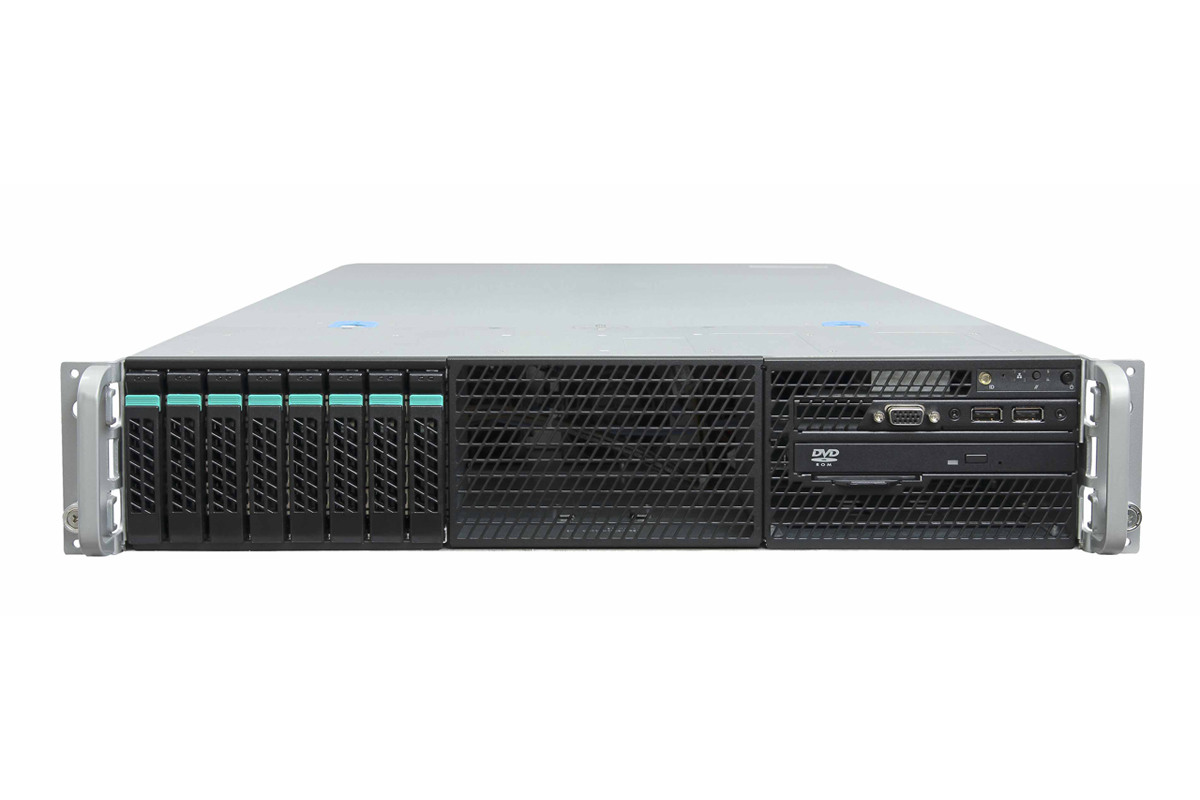Broadberry CyberServe XE5-R2216
In an exclusive review, Dave Mitchell looks at Intel’s Server System R2000GZ 2U rack server, which has memory and storage capacity high on its agenda.
The CyberServe XE5-R2216 delivers supports Intel’s latest Xeon E5 processors and impresses when it comes to storage, memory and expansion. It won’t be beating Dell’s new PowerEdge R720 for quality, features and design but this is reflected in its much lower price tag.

Intel has released a number of unremarkable chassis and motherboards to support its server processors, but the launch of the Xeon E5 CPUs sees a radical shift in direction.
The chip-maker is now going head-to-head with manufacturers such as Supermicro by announcing a huge range of server platforms to house the latest Xeon processors.
We take a look at the Broadberry Data Systems CyberServe XE5-R2216, which showcases Intel's Server System R2000GZ. Codenamed Bighorn Peak', this 2U rack server chassis is one of Intel's premium platforms and comes equipped with its Grizzly Pass' S2600GZ motherboard.

The 8-bay model comes with an optical drive and control panel on the front.
Xeon power under the hood
Broadberry has kitted the system out with a tasty pair of 2.6GHz Xeon E5-2670 processors. These use the new 32nm Sandy Bridge-EP' (efficient performance) architecture which sees the number of inter-socket QPI links doubled and speeds pushed up to 8.0GT/sec.
These 8-core models have a generous 20MB of L3 cache and support the new Turbo Boost 2.0 feature which allows cores to be sped up briefly beyond their TDP rating. During idle periods, the system accumulates a thermal budget and in times of increased activity, uses it to boost core performance for up to 25 seconds.
The E5-2600 Xeons have four memory channels per socket and the XE5-R2216 has the full 24 DIMM slots onboard. In dual CPU systems you can boost memory up to 768GB using RDIMMs or the new LR-DIMM (load reduced) modules. The latter use a buffer chip instead of the register so more memory can be put on each channel and it can run faster.
This particular system shows Intel is taking server storage very seriously as it has an impressive range of expansion options that rival Dell's slinky new PowerEdge R720. The system on review was supplied with 16 hot-swap SFF drive bays but you can opt for 8-bay or 24-bay versions.
The 24-bay model has a slightly different chassis design as you lose the optical drive and control panel at the front. The power and ID buttons have also been moved over to the right-hand edge. Two other models are available that support 8 or 12 hot-swap LFF drives.

The 24-bay version has a redesigned front panel to handle the extra drives.
The motherboard has pair of 4-port mini-SAS connectors, which can handle the latest 6Gbps hard disks. To accommodate the extra drives in the high capacity chassis there's a small SAS expander board mounted behind the drive bays.
Get the ITPro daily newsletter
Sign up today and you will receive a free copy of our Future Focus 2025 report - the leading guidance on AI, cybersecurity and other IT challenges as per 700+ senior executives
Dave is an IT consultant and freelance journalist specialising in hands-on reviews of computer networking products covering all market sectors from small businesses to enterprises. Founder of Binary Testing Ltd – the UK’s premier independent network testing laboratory - Dave has over 45 years of experience in the IT industry.
Dave has produced many thousands of in-depth business networking product reviews from his lab which have been reproduced globally. Writing for ITPro and its sister title, PC Pro, he covers all areas of business IT infrastructure, including servers, storage, network security, data protection, cloud, infrastructure and services.
-
 Cleo attack victim list grows as Hertz confirms customer data stolen – and security experts say it won't be the last
Cleo attack victim list grows as Hertz confirms customer data stolen – and security experts say it won't be the lastNews Hertz has confirmed it suffered a data breach as a result of the Cleo zero-day vulnerability in late 2024, with the car rental giant warning that customer data was stolen.
By Ross Kelly Published
-
 Women show more team spirit when it comes to cybersecurity, yet they're still missing out on opportunities
Women show more team spirit when it comes to cybersecurity, yet they're still missing out on opportunitiesNews While they're more likely to believe that responsibility should be shared, women are less likely to get the necessary training
By Emma Woollacott Published
-
 OpenAI wants developers using its new GPT-4.1 models – but how do they compare to Claude and Gemini on coding tasks?
OpenAI wants developers using its new GPT-4.1 models – but how do they compare to Claude and Gemini on coding tasks?News OpenAI says its GPT-4.1 model family offers sizable improvements for coding, but tests show competitors still outperform it in key areas.
By Ross Kelly Published